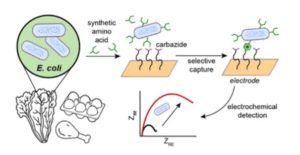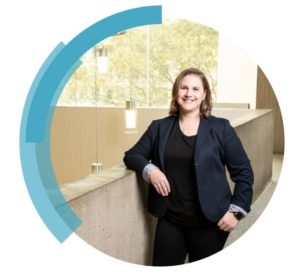Congratulations to Ariel Furst on achieving her first ChemComm Milestone. We are excited to bring you our interview with Ariel discussing her #ChemComm1st article: ‘Covalent capture and electrochemical quantification of pathogenic E. coli‘
Read more below.
What are the main areas of research in your lab and what motivated you to take this direction?
The Furst lab combines biological and chemical engineering with electrochemistry to address challenges in human health and clean energy. We develop new technologies to detect pathogens, combat antimicrobial resistance, degrade environmental pollutants, and improve clean energy technologies. We are motivated by the most pressing global problems: lack of inexpensive, easy-to-use sensors and diagnostics for low-resource settings and dearth of accessible clean energy technologies. Watch our video for more info: https://ilp.mit.edu/watch/ariel-furst
Can you set this article in a wider context?
E. coli are dangerous pathogens, strains of which are responsible for both foodborne illnesses and urinary tract infections (UTIs). According to the USDA, each year, foodborne illnesses impact nearly 50 million Americans, leading to over 100,000 hospitalizations, with an economic cost of over 15 billion dollars. Worldwide, these illnesses cause over 400,000 deaths annually, with a disproportionate impact on children. Preventative measures are critical to prevent these infections and improve patient outcomes. Similarly, E. coli-based UTIs are some of the most common infections, and current diagnostics necessitate centralized facilities and multiple days for diagnosis. Thus, clinicians often prescribe broad-spectrum antibiotics without knowledge of the infectious agent, which leads to recurrent infections and emergent resistances: an exacerbation of both the individual and global problems. We have developed an inexpensive, disposable electrochemical sensor to selectively capture E. coli and accurately quantify them. This technology is a major step toward the implementation of point-of-care and point-of-contamination sensing of these deadly bacteria.
What do you hope your lab can achieve in the coming year?
The Furst Lab is continuing to develop technology to sense dangerous pathogens. We plan to continue to develop diagnostic technologies to detect not only the strain present but also antibiotic resistances in an integrated platform. We are additionally expanding our sensing targets to include the degradation and detection of small-molecule environmental contaminants. We hope to have prototypes of these platforms by the end of the year.
What is the best piece of advice you have ever been given?
Over the years many advisors and mentors have given me great advice, but at the end of the day it’s something that we all learn at a young age, the golden rule: treat others like you would like to be treated. This simple truth extends to all aspects of life and research and ensures that we have an inclusive environment that we can all thrive in.
Why did you choose to publish in ChemComm?
With interdisciplinary work, it is important to reach a wide audience. ChemComm reaches a broad audience and is a great place to share this work. Additionally, the format, a communication, is a great way to share new and exciting work quickly.
Read Ariel’s #ChemComm1st article and others in ChemComm Milestones – First Independent Articles. Follow the hashtags on our Twitter.












